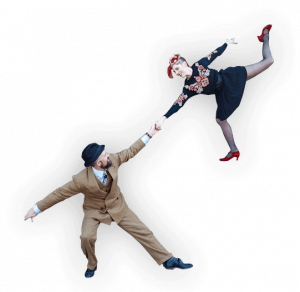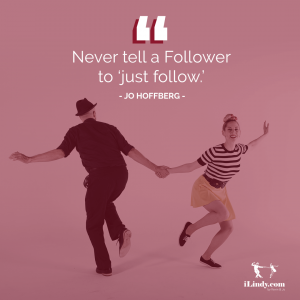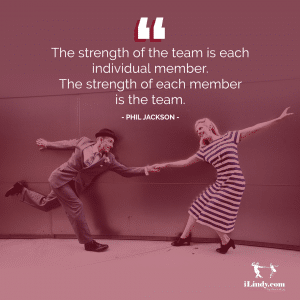There are a lot of different views of what Leading and Following in Lindy Hop are all about. How should the Follower’s role really work? Are Leaders “in charge” within the dance or is that a limited way of thinking?
It’s not just a matter of technique. This is some pretty philosophical stuff.
In that vein, we’d like to share our own philosophy at iLindy of what the roles of Leading and Following within Lindy Hop can be.
It all depends on your mindset.
 For a lot of people, the limitations of language along with influences from other kinds of dance create some intrinsic restrictions. We’d like to bust some of those assumptions and ways of thinking to open up the way that you view the dance partnership.
For a lot of people, the limitations of language along with influences from other kinds of dance create some intrinsic restrictions. We’d like to bust some of those assumptions and ways of thinking to open up the way that you view the dance partnership.
Sure, the words “Leading” and “Following” imply that one person is in charge and that the other person goes along with it — that’s definitely the way that it’s done in ballroom dancing and many other forms of dance — but that doesn’t mean it’s how we have to do things in Lindy Hop.
Leading and Following can be a lot more conversational than “command and obey” — and thank goodness for that! What a boring dance this would be if that’s all that leading and following meant! Leaving behind that mindset is what makes Lindy Hop so much more dynamic, engaging, and appealing.
Never tell a Follower to “just follow” as if it’s incredibly easy request and they’re just being obstinate. It would be similar to “Can’t you just lead that better?” It’s in no way helpful or constructive. ~Jo Hoffberg
Lindy Hop is a social dance first, and then also a performance and competition dance. Look at the culture of Lindy Hop and how it’s danced at its highest level, both socially and at a competitive level, including the strong emphasis on social dancing in the Mix and Match and unchoreographed divisions. You can see clearly how much Lindy Hop values improvisation, collaboration, playfulness, creativity, and self-expression. w00t!
All that good stuff is probably why you fell in love with Lindy Hop in the first place, even if you weren’t conscious of it.
So let’s not allow restrictive ideas about “Leading” and “Following” to close doors for us. Instead, let’s find much more fluid ways of using these roles to prioritize all those characteristics we just described. Because it’s these characteristics that help define our unique Lindy Hop culture.
 Say it with us –
Say it with us –
As a Lindy Hopper, I value:
BOOM. Thank you! Didn’t that feel good?
And to that end, you’re never going to fully embrace Lindy Hop’s potential until you open up your ideas about Following and Leading.
We believe that the dance should be a communicative collaboration between both partners with the Follower contributing equally to the overall shape, direction, and personality of the dance. This is something we actively work on. When both partners have a chance to express themselves, the dance is better. Period.
A few things have to happen in order to really embrace the vast possibilities of the Lindy Hop partnership.
 First comes the “want” and let’s be honest: not everyone wants that kind of collaboration. We’d like to believe that there are actually few of those Leaders out there and that instead, a lot of Leaders just lack the skills to be able to open up the dance for more collaboration. There are a lot of Leaders out there who have only trained to “speak” and not to “listen” with the conversational only going in one direction (psst….let’s call that a lecture). Maybe knowing that we (Kevin and Jo) don’t think that way will help shake up some Leaders’ belief systems.
First comes the “want” and let’s be honest: not everyone wants that kind of collaboration. We’d like to believe that there are actually few of those Leaders out there and that instead, a lot of Leaders just lack the skills to be able to open up the dance for more collaboration. There are a lot of Leaders out there who have only trained to “speak” and not to “listen” with the conversational only going in one direction (psst….let’s call that a lecture). Maybe knowing that we (Kevin and Jo) don’t think that way will help shake up some Leaders’ belief systems.
We absolutely believe in training the skills of leading and following weight changes, tempo and direction changes, and rhythms, but just because we’ve spent hours training those skills doesn’t mean they’re the only ones we use. In every dance, you can implement a wide range of skills to diversify the relationship and make each and every dance unique.
The actual functionality of how fluid Leading and Following all works together, including how to be receptive to the Follower’s influence, isn’t an easy or automatic skill. It’s a skill that has to be learned. So first the awareness needs to be there. Then the desire. Then you can learn the skills.
 The same thing goes for how to actually take initiative as a Follower. This process isn’t intuitive for most Followers. It takes both opportunity and practice. Sure, opportunity can be provided to some extent by the Leader, but it can also be taken. It’s like the old Milton Berle quote: “If Opportunity doesn’t Knock, Build a Door.” Followers in Lindy Hop should train to be ready to create opportunities of their own making as well as seizing those opportunities that are provided to them.
The same thing goes for how to actually take initiative as a Follower. This process isn’t intuitive for most Followers. It takes both opportunity and practice. Sure, opportunity can be provided to some extent by the Leader, but it can also be taken. It’s like the old Milton Berle quote: “If Opportunity doesn’t Knock, Build a Door.” Followers in Lindy Hop should train to be ready to create opportunities of their own making as well as seizing those opportunities that are provided to them.
Follows, there’s one thing that’s important to remember: You want to be able to improvise, play, create, and express yourself in the dance while ensuring that it’s still a collaboration and not just solo dancing on the end of someone’s arm. You might go through some phases that are a bit like that, and that’s ok! But ultimately, if you want to become a really good dancer, empowerment is better equipped when you develop your skillset within the partnership.
“Because I dance both roles, I really enjoy the difference in focus. My ‘leading mind’ challenges me to plan ahead while my ‘follow mind’ challenges me to relax and respond more in the moment. I love being able to switch back and forth depending on my mood.” ~Kevin St. Laurent
 No matter which is your dominant role, both Followers and Leaders need skills in order to foster the empowerment of the Follower. That’s why we make this part of our active training and teaching. There are fundamental skills that will train Followers to become stronger and more confident in contributing and influencing the actions of the dance.
No matter which is your dominant role, both Followers and Leaders need skills in order to foster the empowerment of the Follower. That’s why we make this part of our active training and teaching. There are fundamental skills that will train Followers to become stronger and more confident in contributing and influencing the actions of the dance.
This is an integral part of our iLindy philosophy and you can see it in the way that we (Jo and Kevin) dance and teach. These ideas have been intrinsic to our dance partnership and training for over 12 years. We’ve also been honing how we teach this kind of communication and technique to support Follower empowerment to our students. We’re excited to share more of this philosophy with Lindy Hoppers everywhere here on iLindy.
By the way, it’s up to all of us, but especially Lindy Hop teachers, to foster the empowerment of Followers as part of our community culture. Sure, some of the technique that allows the Follower’s influence to work within the partnership can be pretty subtle and nuanced. But that doesn’t mean that we should wait until Followers are advanced to give them a voice. The mindset needs to be worked into our dance culture from the beginning.
Augmenting the empowerment of Followers in our community takes a shift in mindset from Followers and Leaders and consciousness from instructors and organizers. The language that you use and the example you set matters. The question is, are you ready and willing?
There’s an awful lot to talk about on this subject. So much so that we’ve got a Part II to check out: Personal & Partner Responsibilities in Lindy Hop
Do you have any comments, anecdotes, or questions about empowering Followers in Lindy Hop? We’d love to hear from you! Leave us a comment.
You must be logged in to post a comment.
Fernandosays:
Comprendo lo que se intenta expresar…soy un recién llegado a este modo de vida… tendré que ir paso a paso…un saludo y gracias por las explicaciones…
Lindsay Gsays:
This is one of the many things that makes Lindy amazing! I struggle with teaching this to beginner dancers though. I talk about it in class from the very beginning, but have been at a bit of a loss for having them put it in to practice. I guess I have only ever really seen it taught at a higher level. Do you have any recommendations for teaching it from the start?
Tim Collinssays:
Thanks for your comment Lindsay! Yes, very soon we will be posting Kevin and Jo’s “Trading 8’s” course which delves deeply into the topic. We will be announcing it very soon!
Laiasays:
Thank you. This needed to be written down. Congrats for the post!
Kevinsays:
As a leader, I love it when a follow ads her (usually a female follow for me) own interpretation to the end of a move. However, many times I find that follows will add a flourish to the end of a move but they take too long. I then have to cut them off in order to keep us on time. I feel like that is rude of me so I don’t like it. For example, at the end of a swing out some follows swivels just seem to hang out there, Then when it’s time for me to pull for the next swing out, they are still swiveling. When I am with more experienced follows this never happens and their swivels are timed perfectly. Any tips on that? I think it’s the follows, but I am open to it being my fault.
Luciesays:
Well, maybe she is telling you she doesn’t want to be pulled into the next swing out. Maybe she is telling you to stay in place and keep swiveling for how long she’d like. Why you shouldn’t listen to her? Her creativity is not confined in merely flourishing the end of the move you decided to lead and stay within the timing you had decided to establish. Nope. Read the article again. Listen to you follow ideas, share the dance, have a conversation.
Plus, maybe the more experienced followers don’t try and be creative with you only because they know after a few seconds that you might not able to conversate with them in an equality setting, they just let you lead everything because it’s the only way you have learned to dance. Let them talk and you’ll see expand immensely the possibilities.
Jenny Osays:
Wonderful.
Xin Liusays:
I found it is harder to do it this way in fast tempo. and there must be no aerial steps too. And the willingness of do this seems to be highly related to the personality of the leader.